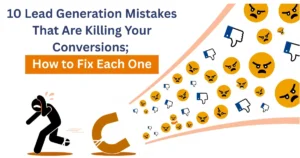Effective lead management comes about with business growth, and the CRM Cleanup guide is the very pivot of it. In time, the data in CRM starts getting unwieldy, reduces effectiveness, and eventually poor conversion rates for leads. This step-by-step guide to CRM cleaning aims at improving your lead scoring, enhancing automation, and optimizing the approach toward lead management. In this course, you will learn how to automate tools, segment leads, and make much of the sales process easier with data-driven insights, thus increasing conversion rates for startups and established businesses alike.
Benefits of recruiting CRM Cleanup services
Keeping your CRM system clean and up-to-date offers several added advantages for businesses seeking to optimize their lead management efforts. Why should cleaning up the CRM system be one of the most important things for a business to do? Here’s why:
- Improved lead scoring: Better data means better lead scoring to improve the focus of your sales team.
- Streamlined sales process: A clean CRM eliminates duplicates and records that are outdated, contributing to a quicker sales cycle.
- Data-driven lead nurturing: High-quality data enables one to craft very targeted and personalized lead-nurturing campaigns.
- More automation: This comes with having CRM cleaning and maintenance automated for huge time saving and reduced manual effort.
- Better lead conversion: Cleaner data, therefore, translates to better conversion rates since your CRM is populated with better-quality leads.
Step-by-step guide to CRM Cleanup
A structured approach to CRM cleanup ensures you get the most out of your CRM tools. Let’s break down each step to help you achieve a more efficient lead management process.
Step 1: Assess the quality of your CRM data
Well, before making a fresh start, take appropriate stock of what is the present state of CRM data. Ask direct questions such as:
- Are there duplicate records?
- Would any of that data be outdated or possibly incorrect?
- Is the correct classification of leads happening?
Running a CRM data analysis at this stage uncovers problems that are usually hidden. Utilize CRM cleaning tools or audit records manually to determine the quality of your CRM system’s data. For startups, CRM management tools like HubSpot or automated CRM clean-up features built into Salesforce will rapidly highlight areas that require attention.
Step 2: Identify and merge duplicates
Duplicate data in your CRM clogs the system and confuses your sales funnel. Many of today’s CRM automation tools can automatically identify and remove or merge duplicates. Most of the more popular CRM systems, such as Zoho or Pipedrive, can handle this task, with solutions already integrated into the system. Businesses that rely on manual methods can easily take a first concrete step by creating standardized methods for data entry to minimize future duplication.
How to automate duplicate merging?
With CRM cleaning tools like Data.com or ZoomInfo, one can save time by automating duplicate data detection. Tools work to keep it clean and actionable without manual effort required for the same.
Step 3: Update and correct inaccurate data
An old CRM is just as much a problem as a dirty one. Every now and then, cleaning through your CRM database will have you updating leads with their latest contact information, company data, or stage in the sales cycle. For bigger businesses, a data cleaning schedule may be necessary to keep your CRM in prime working condition: on a weekly, monthly, or quarterly basis.
CRM data cleansing best practices
- Establish rules for automatic validation of data upon entry.
- Schedule periodic reviews of lead data using CRM data cleansing steps, such as verification from publicly available databases, including LinkedIn and company websites.
- Integrate CRM clean-up tools like Clearbit for validation and updates of customer data.
Refining lead scoring and segmentation after cleanup
Cleaning up your CRM is only just the beginning. When your data’s in order, it’s time to hone your lead scoring and segmentation for better marketing and sales.
Step 4: Optimize lead scoring with clean data
Scoring leads accurately helps in managing the sales funnel. With data cleaned and updated, your CRM lead scoring can be a lot more accurate, and hence, your sales team can focus more on leads that look really promising. For startups, this could be of great help, being at the growth stage.
Using Data-driven lead segmentation
Segment your leads with the use of clean data to build more targeted outreach. Other CRM automation tools, like ActiveCampaign and Marketo, can automate this process by segmenting leads based on their industry, behavior, or previous interaction.
Step 5: Implement data-driven lead nurturing
Data-driven lead nurturing is all about providing the right content and offers to prospects, depending on their behavior and stage in the sales funnel. With a clean CRM, you will be able to refine your lead-nurturing tactics with the latest, segmented data.
Personalized marketing with CRM
One of the biggest advantages associated with cleaning up CRM is personalization. A marketing team can create customized campaigns that will drive engagement and conversion rates with clean, accurate data.
Solutions for automating CRM cleanup
Automation plays an important role in CRM cleanup, keeping your data fresh and actionable without necessarily having you do it yourself. Following are some of the automation solutions to make your life easier with CRM:
CRM automation tools for cleanup
Several tools can automate your CRM cleanup and management tasks. Here are a few solutions to consider:
- Ringlead: It cleans and deduplicates CRM data automatically, ensuring that the leads are up-to-date and actionable.
- Informatica Data Quality: Provides automated data quality monitoring, ensuring that CRM data is clean and updated consistently.
- Cloudingo: This is designed for Salesforce and automates the cleansing process with consistent CRM optimization.
Automated lead nurturing with CRM cleanup
With CRM automation tools, you can trigger automated workflows at any stage in the sales funnel to nurture leads. Example: You use ActiveCampaign to trigger lead scoring and automation around emails and follow-ups based on behavior so you can engage in a timely fashion.
Additional steps to optimize lead management
Besides what can be achieved with a simple cleaning of CRM, further optimization could include the following steps:
Step 6: CRM data analysis for better lead management decisions
Analyzing cleaned CRM data may make decisions a little wiser. Take advantage of analytics functionality built into your CRM system to track KPIs such as lead conversion rates, the length of the sales cycle, and the level of engagement.
Making data-driven CRM strategies
Use CRM data analysis to base decisions for lead management. By identifying which segments of leads convert the best, resources can be allocated more efficiently.
Step 7: Ongoing CRM data quality maintenance
Clean-up of CRM is not a one-time activity. Schedule repeating data maintenance routines that will keep your CRM at its best. Clean your CRM data periodically to avoid data building up; this would be best done through quarterly audits.
Conclusion
Cleaning up your CRM system is so essential to maximum lead management and smoothly flowing sales funnels. By following these processes, assessing data quality, and leveraging CRM automation tools, businesses can enjoy higher conversion rates and more efficient lead nurturing.
It can be a start-up or an established business; investment in the regular cleanup of CRM data and its automation will help save time, smooth the sales process, and thus grow the business. Keep the CRM clean, and keep it that is the most important thing in optimizing lead management for long-term success.





Leave a Comment